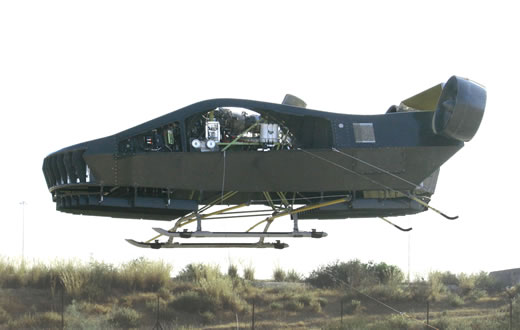
Above: The AirMule prototype has performed 40 test hovers and accumulated 10 hours of flight time. More recently the aircraft has been undergoing a systems upgrade including the development and installation of wheeled landing gear that will facilitate ground mobility while also enabling STOVL (Short Takeoff Vertical Landing) operations which have the potential to nearly double the aircraft’s payload capacity. Urban Aeronautics plans to resume flight tests of its AirMule prototype before the end of the year. Photo: Urban Aeronautics
The U.S. Navy is expecting proposals from industry for groundbreaking operational support services, employing unmanned helicopters as ‘Cargo-Unmanned Aerial Systems – C-UAS) in Afghanistan. Two companies are expected to compete for this service – Lockheed Martin-Kaman and Boeing. Boeing positions it’s A160T Hummingbird rotary wing UAV as an unmanned cargo lifting platform. The A160T is likely to face a larger and tough competitor, the ‘Unmanned K-MAX’ from Lockheed Martin and Kaman. For the long term, dedicated platforms are being developed for such roles, as well as a new category of ‘transformers’ flying cars, developed under a new initiative embarked by DARPA. Following are some of the highlights of these new programs.
Far Sighted Designs

A dedicated cargo UAV is currently in development in Israel – the AirMule, an aerial vehicle designed specifically for multi-role tactical utility missions. The AirMule is equipped with internal lift rotors and has a small footprint, qualities that make it particularly suitable for vertical mobility in urban environments. The AirMule has an empty weight of 1400 lbs (640 kg) and maximum load of up to 1900 lbs (860kg). The AirMule carries fuel to support up to 8 flight hours or 600 nm (1080 km). The aircraft has multiple-mission capabilities with the current emphasis being on unmanned casualty evacuation and cargo resupply. It is measured for internal carriage inside CH-53 type helicopters, enabling rapid and efficient global deployment. The AirMule is being evaluated by the Israeli Medical Corps and Israel MOD for potential use as an unmanned airborne casualty evacuation (CasEvac) system.
So far the AirMule prototype has performed 40 test hovers and accumulated 10 hours of flight time. More recently the aircraft has been undergoing a systems upgrade including the development and installation of wheeled landing gear that will facilitate ground mobility while also enabling STOVL (Short Takeoff Vertical Landing) operations which have the potential to nearly double the aircraft’s payload capacity. Urban Aeronautics plans to resume flight tests of its AirMule prototype before the end of the year.
The U.S. Army is also looking into an unmanned aerial platform to operate as ‘combat medic unmanned aircraft system’ (CM-UAS), an aerial vehicle that will be able to respond to calls for evacuation or urgent resupply, by automatically navigating to the requested location, where it liaises with the party calling for the support to get landing instructions. As it touches down, the medics unload the medical supplies, load the casualties, flying back to the forward medical treatment point without putting a manned aircrew at risk.

Another new Israeli design is the IAI Panther family of tilt-rotor UAVs. Two versions of the Panther are already flying, the larger 65kg vehicle is proposed for the Israel defense Forces ‘brigade UAV’ program currently underway. Yet IAI has high hopes for the patented three-prop design, scaling up the current version to a helicopter size vehicle capable of carrying two passengers or an equivalent weight in cargo. The current vehicle is powered by electrical motors but the heavier versions could employ more efficient internal combustion engines. An interesting feature of the Panther is its flexible takeoff and landing configurations – for example, it can takeoff on a short runway with semi-tilted props and, after consuming part of the fuel, land vertically at its destination.

DARPA is working on a concept flying vehicle that could replace today’s tactical utility vehicles – at least in part of their missions. According to Program Manager Mr. Stephen Waller, the TX vehicle is intended to make roads irrelevant for military small unit maneuvers. Units will be able to use TX air vehicles to fly over obstacles or impassible terrain, avoiding ambushes and improvised explosive devices (IEDs). Personal TX vehicles could be dispatched for downed airman recovery or for evacuating injured personnel from difficult to access locations, or to resupply isolated small units.
The Transformers are still in their infancy. At the current stage the goal of the program is to define the major components and overall design of a TX vehicle that would be suitable for military scouting, personnel transport, and logistics missions. Under the program DARPA is planning to explore a hybrid electric drive ducted fan propulsion system, lightweight ring motors, and energy storage methods such as batteries and ultra capacitors. Other fields for innovation include morphing vehicle bodies, and advanced flight controls and flight management systems.

DARPA wants to assess these technologies as part of a true TX vehicle. In September 2010 AAI was awarded a first $3 million contract by DARPA, to design a ‘flying jeep’ under the ‘Transformer’ (TX) program, seeking to develop a vehicle that will be able to travel on road and transform on demand into a vertical take off and landing flying machine. Such vehicle should be able to travel 250nm (463km) on land, carrying four passengers. The second system integrator selected by DARPA for the program is Lockheed Martin. Their concept was reportedly based on its Phantom Works project that combines aspects its Joint Tactical Light Vehicle, mated with with a ducted fan propulsion system for flying. Lockheed Martin is also associated with Gibbs, on the development of hybrid marine-land vehicles that could also be combined for the program.
The first phase will involve trade studies at different configurations, among various rotor-powered options under study are the SR/C concept and autogiros. DARPA is planning to spend obout $54 million over the five year program.




















